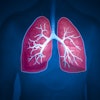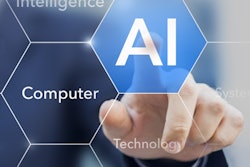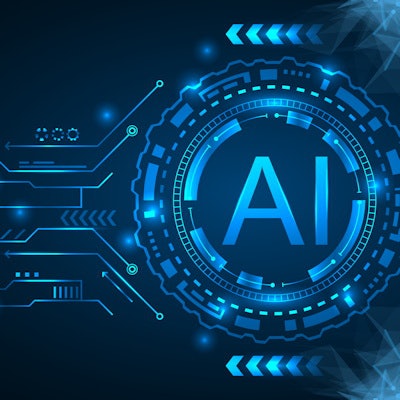
The second part of an international survey of over 1,000 radiologists and residents about artificial intelligence (AI) in imaging has shown that nearly 80% of respondents want the subspecialty to be included in residency training. The survey shines a light on what role AI is expected to have in the future and the perceived hurdles to its implementation.
"The survey was aimed at highlighting the perceived soft skill- and human issues involved in the implementation of AI. People in the field tend to look at the technical requirements to implementation, but people are starting to realize that these 'human elements,' such as the willingness to change management style to drive change, may even be more important than technical issues," noted Dr. Merel Huisman, PhD, winner of the 2021 EuroMinnies award for Radiology Rising Star.
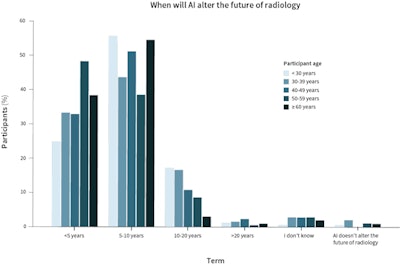 Chart shows when AI is expected to alter the future of radiology, according to the age of the participants. Figures courtesy of Dr. Merel Huisman, PhD, and colleagues, and European Radiology.
Chart shows when AI is expected to alter the future of radiology, according to the age of the participants. Figures courtesy of Dr. Merel Huisman, PhD, and colleagues, and European Radiology.Part 2 of the survey was published online by European Radiology on 11 May. Overall, the research showed that most people believe AI will cause major changes to the field of imaging within 10 years. But while most (79%) wanted residency curriculums to include AI topics, only 23% wanted AI to be recognized as a subspecialty.
Key findings
A multinational team of researchers led by Huisman, a final-year radiology resident at University Medical Center Utrecht in the Netherlands, and Dr. Martin Willemink, PhD, of Stanford University in California, disseminated the survey on AI between April and June 2019 and results about attitudes to AI were published online on 20 March in European Radiology. Part 2 focused on future expectations, hurdles to implementation, and education.
Among the 1,029 respondents, the most frequently cited role for AI over the coming decade was as second reader (n = 829, 78%) and for workflow optimization (n = 802, 77%). Partial replacement was the third most frequently cited (n = 493, 47%). Only 11 participants (1%) said that AI would fully replace radiologists.
Meanwhile for anticipated hurdles to AI implementation, a total of 1,024 out of 1,041 (98%) respondents cited ethical and legal issues (n = 630, 62%). Other answers included a lack of knowledge among stakeholders (n = 584, 56%), and limitations in digital infrastructure (n = 356, 35%).
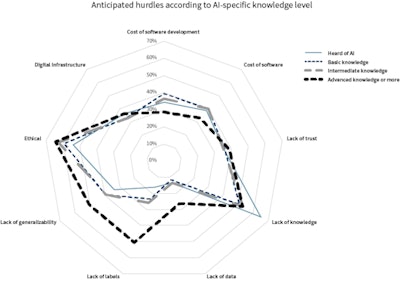 Anticipated hurdles to AI, according to AI-specific knowledge level.
Anticipated hurdles to AI, according to AI-specific knowledge level.Only respondents with advanced AI-specific knowledge indicated a lack of well-organized datasets as well as generalizability issues as potential hurdles: 28% (n = 287) of all respondents cited a lack of high-quality labels as a challenge to implementation.
The majority of respondents (n = 780, 75%) indicated that they were planning on learning more about AI, while only 6% (n=63) did not plan to learn more about AI at all.
"Radiologists must be willing to leave their comfort zones and expand their knowledge in the topic rather than experiencing implementation as a top-down decision," noted Huisman. "One way to boost knowledge would be to modify residency programs to include subjects such as biostatistical concepts beyond what's included in traditional medical studies and data science, tailored to the understanding of the capabilities as well as the risks tied to digital innovations."
The major surprises
Huisman noted that not all results had been foreseen. The survey revealed that respondents most frequently cited that AI would impact second reader strategies and workflow optimization, she added. In the past, these 'softer' roles have been overlooked, as the focus was placed on AI's expected role as a standalone tool for detection and diagnosis.
"These other assisting roles such as workflow optimization aren't as sexy as detection, but they're highly important, and probably easier to implement as less patient-related risks might be involved" she noted.
Other surprises were seen in the section on expected challenges to AI: The authors anticipated that digital infrastructure would be considered a top challenge, next to obviously ethical and legal issues, yet this was only mentioned as a hurdle in 35% of responses. Lack of AI-specific knowledge was the biggest anticipated hurdle after ethical and legal issues. Both lack of knowledge and ethical and legal issues could be addressed through changes in education, noted Huisman, who suggested the inclusion in radiology training of topics related to regulations and guidance such as cloud risks and ecosystem personnel roles.
The results indicate that the radiological community is becoming aware of hurdles such as ethical and legal issues and lack of knowledge, but perhaps at the expense of overlooking the need for well-curated datasets and AI generalizability, which seemed to only be considered by those who already had advanced AI knowledge, according to Huisman, pointing to the need for such topics to also be included in residency training.

